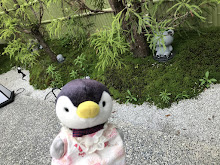It is said that it was established in 778 when a monk, Kenshin, had discovered pure water at Mt. Otoha and started his training.
Pass through Kiyomizu-do Street to Kiyomizu-dera Temple
From the bus stop, you will go up the slopes. Both sides of the slopes are shops and it is always crowded with many people. Kiyomizu-do street is the entrance to Kiyomizu-dera Temple. The altitude is about 50m, and it goes up about 40m from here to Nio-mon gate. This area is always crowded with many tourists. Many attractive souvenirs will catch your eye, but let's enjoy shopping after visiting the temple.At the end of the slope, you will see Nio-mon Gate. This is the gate made in late Kamakura period (1192-1333) and designated as national treasure.
After passing the gate, you can look around the beautiful sights.
Buy a ticket to enter the main hall
Ascend the stairs and proceed to the west gate and triple tower.
West gate was built in 1631 in the Edo period and is an important cultural property of the country. It is a little special gate and valuable, but cannot be passed through and you can only see the appearance.
When you pay the admission fee at the front window, you will be given an entrance ticket. This ticket is with beautiful print of Kiyomizu-dear temple and it changed every season. Just show your ticket and you will enter “Kiyomizu-dera Temple” now.
Kiyomizu-dera Temple(Main Hall)
The main hall of Kiyomizu-dera Temple is designated as a national treasure.Tokugawa Iemitsu donated it and was rebuilt in 1633. The current building has a structure that protrudes over the cliff called the "Shimizu stage". Currently the main hall is under-construction,
with cost about 4 billion yen, and the main hall was covered with tarpaulin while the cypress roof was being replaced. However, you still can stand on the stage of Shimizu, and you can visit the inside of the building. The construction is expected to be completed in March 2020.
When you make a big decision, it is said to "jump from the stage of Shimizu". In the Edo era more than 200 people actually jumped with courage. However, it has been banned since 1872 and no one jumps off now because it is considered bad customs.
The main statue of Senju Kannon is a secret Buddha that opened once every 33 years. The next opening is estimated to be around 2032.
After you pass through the main hall, turn left and go to the Jishu shrine.
Jishu Shrine
The Jishu shrine worships the landowner deity of the land, and is believed to have already worshiped during the Jomon period.Okuninushi-no-Mikoto is the priest's god, and during the Heian period, Emperor Saga, Emperor Enyu, and Emperor Shirakawa were visited here. This shrine is also known as cherry blossom spots.
The current shrine was built by Iemitsu Tokugawa in 1633, and the main shrine, Haiden, and the main gate are designated as important national cultural properties.
The deity is famous as the god of marriage, and it is a very popular spot for young women and couples. In the narrow precincts, there are two guard stones, the "Fortune-telling Stones'', which are about 10 meters apart. It is said that if you can reach the stone with your eyes closed, you will be in love.
Okunoin / Otowa Falls
Okunoin is also an important cultural property of Japan. From the Okunoin you can see the main hall of Kiyomizu Temple. As you proceed from the back of Okunoin, you can slowly descend the slope to Otowa Falls. If you are in a hurry, go back and go down the stairs from the side of the main hall to get to Otowa Falls. Otowa Falls has spring water flowing down from three wooden lines, and this is the spirit water from which Kiyomizu-dera was named. You can actually touch the spring water with the ladles.Please note that the paid area of Kiyomizu-dera Temple is a one-way street and cannot be reversed. The time required for sightseeing is approximately 60 to 90 minutes from Nio-mon gate.
Enjoy strolling around Ninen-zaka and Sannei-zaka
Lunch and dinner at Kiyomizu-dera Temple are not a problem, as there are many retaurants as well as souvenir shops on Matsubara Street. However, it is always crowded, so it would be nice to be able to take measures such as shifting the daytime well. You can also have your lunch at Ninen-zaka and Sannei-zaka which connects to Matsubara Street. Those area is one of the most famous tourist spot in Kyoto and it has been bustling for a long time as the approach to Kiyomizu-dera Temple on a cobblestone slope.
Please also see the below article:
Ninen-zaka / Sannei-zaka : The approach to Kiyomizu-dera Temple
■Kiyomizu-dera Temple
HP: https://www.kiyomizudera.or.jp/en/Address: 1-294, Kiyomizu, Higashiyama-ku, Kyoto-shi, Kyoto, 605-0862, Japan
Phone: 075-551-1234
Admission fee: JPY 400(adult) JPY 200 (child)
Opening time: 6:00-18:00
《Access to Kiyomizu-dera Temple》
From Kyoto station, you can take a bus. You can also walk to the temple but it takes about 40 to 50 minutes. The one way ticket is JPY 230, but it is recommended to buy “1-day pass” for Kyoto City bus. When you arrive at Kyoto station, you need to find the bus station. Try to find “Karasuma exit” which is the side you can see Kyoto tower just in front of you. The bus stop of Kyoto city bus which goes to Kiyomizu-dera temple is D2 or D1. Get off the bus at “Gojyo-zaka bus stop” or “Kiyomizu-michi bus stop”.The other way is to take a taxi. If you are 3 or 4 people, it might be better to take a convenient taxi than to wait on a long line of bus.
















No comments:
Post a Comment